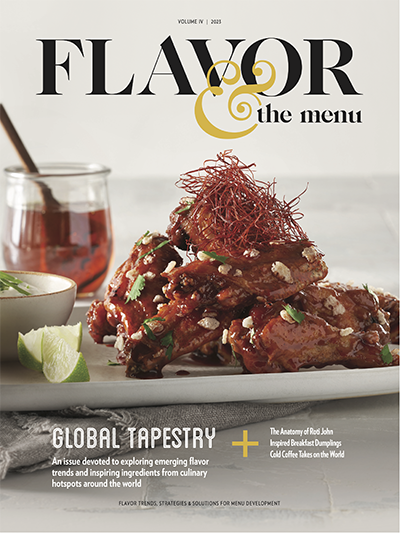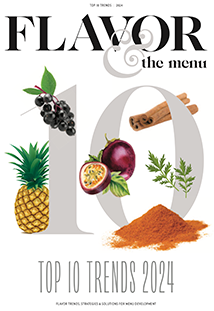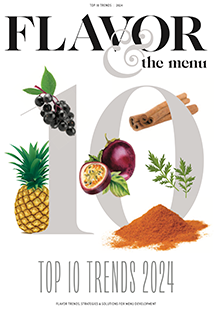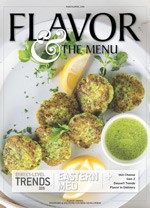It seems nearly everyone is either in the delivery game or figuring out how to ante up. Delivery is clearly a growing part of foodservice: According to Cowen and Company analysis of NPD Group data, total 2014 gross merchandise volume in delivery was $31 billion. In 2018, that number climbed to $47 billion, and by 2022 it’s projected to grow to $76 billion.
But as brands strategize on how to optimize the delivery part of the market, a number of significant challenges arise. How does a restaurant concept guarantee a flavor experience that reflects the quality of its brand? How does it translate its brand beyond the restaurant’s walls and ensure that the all-important emotional connection is made between the guest and the hospitality provider?
Without the strategic use of ambiance, service and dining experience, how do restaurants build brand loyalty?
 McAlister’s Deli
McAlister’s Deli Going against delivery trends, McAlister’s iced tea is its No. 1 selling delivery item, demonstrating a success story in leveraging a brand icon. Other top-ranking delivery items include the French Dip and its most popular sandwich, The McAlister’s Club.
“Delivery is not a temporary phenomenon—it’s here to stay,” says Neil Culbertson, founder of Growth Partners, a restaurant industry marketing and consulting firm based in Denver. “The question is: How does the consumer perceive an in-home experience relative to other options? The answer seems to be that they don’t compare it to other options. Instead, they approach delivery from the mindset that they’re staying home and need to figure out what they’re in the mood for. They’re recognizing that there’s a trade-off for that convenience when it comes to quality of experience.”
Consumer expectation for the at-home experience of restaurant food is hugely important when it comes to strategy in the delivery space. It also needs to be calibrated against the overall brand impression that may impact future restaurant visits. After all, the underlying concern is that if a french fry is lukewarm and limp in a delivery experience, the consumer will—if even subconsciously—link that quality of fry to the restaurant brand and not just the circumstance of time plus travel.
“People will sacrifice quality and flavor for convenience,” says Maeve Webster, president of Menu Matters, a foodservice consultancy. “But how many times will it take for that to lead to a perception that the food in that restaurant is not good?” If the answer is any number above zero, that can impact craveability, which remains the brass ring in foodservice.
 Pincho
Pincho Pincho pre-packages sauces and dressings to help maintain the flavor experience of salads and bowls, like this California Chicken Salad.
A Different Mindset
McAlister’s Deli, an Atlanta-based fast-casual sandwich concept with more than 400 locations nationwide, has been ramping up its to-go and delivery program over the last year or so. Although integrity of product remains paramount to the brand, its research shows that consumer expectation is indeed lower with delivery. “Delivery is becoming more mainstream, so consumers’ expectations are more realistic today,” says Brandy Blackwell, director of off-premise marketing for McAlister’s. “What people care about is that the food isn’t mushed together, not tipped over sideways, and that none of the order is missing.”
Granted, McAlister’s menu of sandwiches, soups and salads is less challenging than some full-service menus. “Our menu is not that sensitive to various temperature conditions,” says William Eudy, McAlister’s corporate executive chef. “Our focus here revolves less around technology and more around efficiencies back of house to speed up service.”
Pincho, a Miami-based fast casual inspired by Latin street food, first approached delivery cautiously and started with a limited menu of items that travel well. “If the food’s our hero, we wanted our customers to have the same experience as they would have in the restaurant,” says Otto Othman, CMO and founder. A few of Pincho’s popular menu items were left off the delivery menu intentionally, including the Tostone Burger, a patty topped with Monterey Jack, lettuce, tomatoes and homemade cilantro sauce, all tucked between two fried plantains.
“There was concern that the fried plantains would arrive in a mushy rather than crispy state,” he says. “But people didn’t care. They wanted that burger—even knowing it wasn’t going to be the same. So we re-thought our delivery strategy and ended up making everything available. The person who is going to pay $5 for convenience doesn’t care as much about quality—they just want what they want at home, in the office, and so on.”
But although both Pincho and McAlister’s recognize that consumers today carry a more relaxed attitude toward quality of product in the delivery space, they still understand that it’s a fight for share, and are in it to win it.
 Pincho
Pincho Pincho’s burgers used to be wrapped in aluminum for delivery, but a shift to vented clamshells keeps the components from getting too soft.
A Flavor Approach
Of course, optimized flavor experiences are still the goal, even with the cushion of a more accepting at-home consumer. The mechanics of ensuring the best possible product requires thoughtful attention. Pincho shut down its third-party delivery service last April because the chain couldn’t keep up with the demand. It used that time to streamline its systems. “We figured things out internally—from packaging for better integrity of our products to speed of service,” says Othman.
To better preserve crispiness of fried items, like french fries, and maintain textural integrity of burgers and sandwiches, Pincho moved to vented packaging. “We were wrapping our burgers in aluminum, but it was steaming the product and making everything soft,” he says. “We moved to vented clamshells and did the same for our sandwiches.”
To avoid delays during rush periods, the back-of-house staff also started pre-packaging sauces and dressings in to-go souffle cups. “It was a simple fix that saved us a lot of time in assembling delivery orders,” says Othman.
The chain also switched from adding a sauce to a bowl build, treating it more like a salad, with the sauce offered on the side. “The sauce was getting warm and steamy in the packaging, which didn’t make the bowl as delicious as it should be,” he says.
Pincho also had to solve the beverage side of delivery. “Prepping drinks for delivery was an operational nightmare, but we needed to figure it out because that soda sale helps immensely with profitability,” he says. The brand opted to ditch fountain drinks and replace them with tall, slim cans of Pepsi. “We didn’t want to be too fast-food-like. We wanted it to be different. It’s doing great for us, helping with both sales and differentiating our delivery experience from our competition.”
Making a signature brand move, like the less-common Pepsi cans, can strengthen that connection between restaurant and consumer, reminding the consumer that the delivery experience is singular to that concept. The No. 1 selling delivery item at McAlister’s is its famous tea, providing an easy differentiator in a crowded marketplace. “Beverage orders are typically so much lower with third-party delivery,” says McAlister’s Blackwell. “It says a lot about a signature item that our iconic tea is our biggest seller.”
Leaving Love Notes
How else does a restaurant ensure a valuable connection to its guests without the multiple touchpoints offered in the restaurant setting? “It’s so important to extend your branding outside of the four walls,” says Growth Partners’ Culbertson. “Maybe it’s messaging in the bag that’s as simple as: ‘We hope you enjoy your food!’—or something more elaborate. The point is to bring a touch of hospitality into the delivery experience.”
McAlister’s Deli has worked hard on building that consumer connection, which can be especially challenging when using third-party delivery services like Uber Eats, Caviar and DoorDash. “That lack of interaction and customer data is a daily challenge with delivery,” says Blackwell. “Once the food leaves the premises, we lose control.”
To help solve for that, the chain has implemented a tamper-proof sticker system that lets the customer know that McAlister’s wants the food to be perfect, and if it’s not, to please let them know. “That way, the burden is on us, not the third-party delivery company,” she says. “Everything from our sticker to our packaging to our speed of service to any handwritten notes that get tucked in—it all represents our brand and is critical in how we tell our brand story in the delivery space.”
Stepping Stones
Village Tavern, a neighborhood eatery based in Winston-Salem, N.C., is taking a cautious approach when it comes to delivery. The 10-unit casual-dining concept is concentrating on its to-go program, using it as a stepping stone to delivery. “We want to preserve the integrity of the food. The goal is to get better here, then we’ll possibly move into delivery,” says Mary Grace Viado, corporate executive chef.
Everything at Village Tavern is made from scratch, and she takes tremendous pride in its quality. “From the moment an order leaves, I worry about how it will appear, how it will taste. We don’t have control, but I want our customers to have a good experience so they trust us,” she says.
Assembly for to-go orders is now a big part of the back-of-house operations, where every dish is photographed for specific handling instructions for back-of-house staff. For hot items, Viado is working on a labeling process for reheating instructions. “We’ve had to-go since day one, but it’s a bigger part of our business now because that’s the way the industry is going. There’s a change in the marketplace, and we have to react to it—all while ensuring we’re giving our guests the best experience possible,” she says.
When looking ahead at delivery, Viado is weighing the option of in-house delivery versus third-party. “It’s something for us to think about,” she says. “We want that connection to our guests so that when they call, either the bartenders or hosts can take the order and offer up our brand of customer service.”
 Village Tavern
Village Tavern Before getting into the delivery game, Village Tavern is optimizing quality control on its takeout procedures, providing staff with photo instructions for items like its Ahi Tuna Sashimi.











